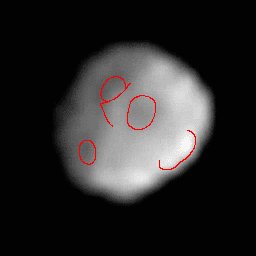Emily Lakdawalla • Jun 13, 2011
A Vesta rotation movie from Dawn!!
What do you know! I spend my last pre-vacation post whining about the lack of image releases from Dawn as it approaches Vesta and what do I find in my Inbox on the morning of my return to work but: an image release from Dawn! Actually, it's better than that. It's a movie, composed of 20 separate images. In it, Vesta is still not much more than a fuzzy blob. But we're getting the very first hints of surface features. Hooray, and thanks to the Dawn team for changing your minds and showing us the view from the windshield as our robotic emissary approaches an unexplored place in the solar system!
ANIMATION HERE
The images are detailed enough to show that funky peak at the south pole that suggests that most of Vesta's southern hemisphere is one huge impact crater. There are some apparently bright spots and some dark spots that you can track as Vesta rotates; some of these may be areas that are actually lighter- or darker-colored than other areas, while some may appear lighter or darker due to topographic shading. If I were a betting person (and if anyone would take me up on it) I'd bet that the thing I'm pointing out in the yellow circle below is a biggish impact crater rotating in to view from the night side. First you see it as a divot cut out of the terminator, then as a bump sprouting out of the terminator (which would be the far wall of the crater, facing the sunlight, appearing brighter than the plains around it), then as it rotates more into sunlight it kind of disappears. At least that's what I see.

Still, at this stage, trying to figure out what the bright patches and dark patches mean is kind of like taking a Rorschach test. It was a Rorschach test even with the Hubble images, which are still better than Dawn's images (or at least they were as of the date that the images for the movie were taken, two weeks ago; Dawn's probably got a better view than Hubble has ever had by now).

It's wise to remember that when images are not detailed enough for their interpretation to be obvious, the human brain will do its best to make up details where none exist. And our brains are hardwired to see certain things. We see circles and lines where there are none, and we are especially wired to see faces. Even I see a face in these views of Vesta:

I think the Face on Vesta is telling me: "Stop! Don't overinterpret these images!" I'll try not to. But it's fun to speculate!
Support our core enterprises
Your support powers our mission to explore worlds, find life, and defend Earth. You make all the difference when you make a gift. Give today!
Donate

 Explore Worlds
Explore Worlds Find Life
Find Life Defend Earth
Defend Earth

